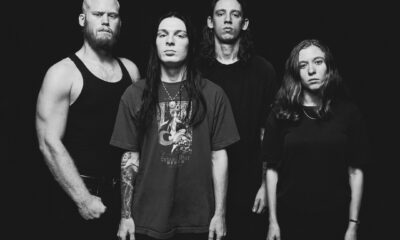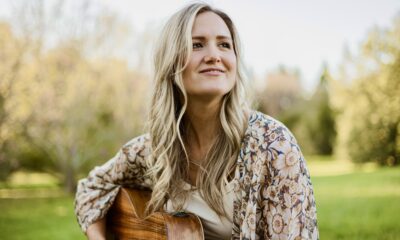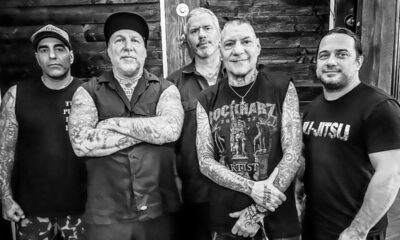Interviews
Interview with Black Breath; Haunted Houses, Rehab-ed Legs and the “Serial Murder Rabbit Hole”
Slaves Beyond Death, is an expansion of previous works which heralds lengthier songs, more dynamic song structures, varied tempos and a springboard into a new deep end by vocalist Neil McAdams.

After enduring a trying time in which its members didn’t even know if they’d be able to continue on after drummer Jamie Byrum came up on the losing end of a bike collision with a car, crusty Seattle-based death thrashers Black Breath worked around their drummer’s recovery and rehab, taking a nosedive into death metal’s older school in the process. The result is third album Slaves Beyond Death, a wholesale expansion of previous works Heavy Breathing and Sentenced to Life which heralds lengthier songs, more dynamic song structures, varied tempos and a springboard into a new deep end by vocalist Neil McAdams.
Captured once again by Converge guitarist Kurt Ballou at his GodCity Studio in Salem, MA, Slaves Beyond Death is one of those records that’ll take fans some getting used to, but once the adjustment period is hurdled, the violent expression and punk rock energy will present itself, albeit in a slightly sculpted and different attack formation. A few days after returning home from a North American run with Goatwhore and Theories, we caught up with Byrum, McAdams and guitarist Eric Wallace to discuss all that went into the new album, something called “the serial murder rabbit hole” and the disappointment that followed their staying in supposedly haunted accommodations while working in Salem.
So, how haunted was the house you were shacked up in whilst recording at GodCity?
Eric Wallace: We stayed in a couple places: The Salem Inn and The John Edwards house. Both are walking distance to the studio and older than most any structures where we live in Seattle. There are a few well-documented characters that are said to haunt the joint, and while I heard my fair share of strange noises and bumps in the night, I didn’t come face to face with any ghosts. We all seemed to have extremely fucked up dreams while staying there, although the place was quite pleasant at first glance.
Supposedly, a man abused and murdered his wife there and I believe I read stories of a little boy and a cat still haunting the place. [Bassist] Elijah [Nelson] and I tried to stay up late one night drinking the house brandy provided in the lobby in order to meet the apparition said to roam the hallway right outside, but I think all we succeeded in doing was emptying their bottle. As far as the John Edwards House, I slept in total peace there, although I’m not aware of any nefarious past with that location.
Jamie Byrum: The John Edwards House was this gigantic three-story house built in the mid 1800s which we were fortunate enough to have all to ourselves. It appeared to be furnished from decades past as well and made for a very cool atmosphere to devote ourselves solely to the project for two weeks. It was also half a block away from an extremely old cemetery. I definitely spent some nights wandering it in the snow drinking wine to clear my head.
Neil McAdams: The John Edwards House had rooms on the top floor and that’s where three of us slept. There was a small attic hatch in the ceiling that would stare at me for hours. At night, you could hear things scratching around behind the walls. It was probably rats. But you never know.
Check out the song “Home of the Grave” here.
How did the recording of the new album go in comparison to previous engagements with Mr. Ballou?
Wallace: I thought it went smoother in some regards and a little more hectic in others. We spent fourteen days in the studio, but due to a slight miscommunication, I thought we had one more day than we actually did to mix the thing. So, that was a little stressful when I realized we were supposed to be done with everything in an hour, not another full day! Overall, I thought it went pretty well, just extremely long days and not a ton of sleep. By the end of the two weeks I couldn’t feel my fingertips at all from playing so damn much. Jamie probably has a unique take on his experience because he was still recovering from an injury that he can tell you more about…
Byrum: At the beginning of the year, I was run over by a car and had my left leg broken in four places. I spent three months in a wheelchair, another three months on crutches and had to go through physical therapy and basically learn how to walk again. That complicated things with drumming for sure. Luckily, the band pitched in and got me an electric drum set after the first month and I started jamming to records from my wheelchair. By the time we got to the studio, I was walking without the aid of crutches, but definitely still in recovery. By the fourth day of tracking drums my leg started really giving me problems and by the final day it barely worked at all. That was extremely stressful and at one point I thought we were going to have to axe a song because I simply couldn’t play it any more. The blast parts in “Reaping Flesh” only exist because I couldn’t play the double bass part I wrote, so I started hammering the shit of these blast beats out of sheer frustration and anger. At the end of the day it all worked out with a lot of patience and expertise from Kurt and a whole lot of blood, sweat and tears.
McAdams: This was the first time we didn’t drive out to GodCity. Our previous times recording we would all be at the studio almost all day, everyday and then we’d grab the cheapest hotel in Danvers and stay up until three or four working over parts. Staying in Salem was different. There was more privacy and a little less stress. We weren’t paying to use the toilets at Dunk’s and if you weren’t tracking you could sleep in, take a shower and feel more human while your ripping your mind apart for two weeks. And we were never late to the studio.

Before I ever had a chance to hear the new album, friends and colleagues who had were all over telling me how much more classic death metal it was when compared to your other works. After hearing it, I agree somewhat, but I also noticed that, on average, the tempos appear to be more mid-paced. Agree/disagree? Is this something you saw coming and/or deliberately directed the new album towards?
Wallace: Since the songs are all longer than our previous stuff, it didn’t seem like a good idea to write a six-plus minute song that was all fast parts. So, we tried to mix it up a little more within the songs to keep things moving along, and to challenge the patterns we might fall into while arranging songs. I haven’t really compared Slaves Beyond Death side-by-side to our past records, but the tempos seem more varied to me, so you could be right. The writing approach for this record was a bit of an ongoing experiment as we went from start to finish, and the only thing we were going for was a more expanded, blown-up version of our approach to creating heavy songs and riffs.
Byrum: While I agree the tempos are more varied, I think calling this a “mid-paced” record would be very misleading. We absolutely pushed the envelope – for us – in the speed department and the majority of the riffing and BPMs are noticeably faster than anything we’ve done before. We kind of already did the ‘short, fast, loud’ thing with Sentenced to Life so we thought it was time to change it up. Looking back at it now, the record almost reminds me of a more sped up, death metal version of Trouble’s The Skull (which was absolutely an influence) in regards to the use of melody and the way the record moves along in a more grandiose kind of way. That is just my opinion and I’m sure other people will hear it a completely different way and that’s what makes it all fun.
McAdams: It rips and crushes and slams. And then gives you a speedball and hits you in the face with a bat. It’s a very dynamic record and with such long songs there was a lot of room to experiment with. If some of it seems mid-paced, it will almost always be faster live. Get ready.
To what do you attribute the differences between Slaves Beyond Death and previous albums to? What would you say has had the most noticeable impact on your collective headspace going into this album: different influences? Growing amounts of experience? Getting older and more jaded?
Wallace: I’d say it’s a combination of all of that to different degrees. More experience is an obvious one, as yet again the stuff on Slaves Beyond Death is stuff we couldn’t have come close to doing on Sentenced to Life. Just as the stuff on Sentenced to Life would have been out of reach while we were recording Heavy Breathing. Each album pushes us to come up with songs we can barely pull off at that moment in time, haha.
Byrum: I also agree that all the things you mentioned are applicable. We played a lot of shows and listened to a lot of killer new music in the time between Sentenced and Slaves. That’s bound to have an impact. Life in America, for me personally, feels a lot bleaker and darker now than it did during the years past. Maybe it’s my imagination, but I don’t think so. Poverty, addiction, suicide, homelessness, disease, gentrification are real issues these days living in this psychotic, murderous police state and are all things members of the band had to deal with to some degree during the making of this whole project. That’s also bound to have a reflection in our art… Basically, the honeymoon is over, haha
McAdams: Jamie is right. Everything here in the states is super fucked. You can’t live here and not be touched by these horrific things. As I get older, it just gets clearer and more terrifying. Like waking up one day and realizing that you’re living in a Philip Dick novel and everything is so fucked. This madness is in our blood and it’s all influence. Every kid shot on a corner. Every corpse fished out of the bushes off the highway. All the hate and violence in this world is just inches away from lashing out and leaving you jumped, stabbed, raped, shot or dead. We all live so close to death and as time goes buy you see it coming nearer and nearer.
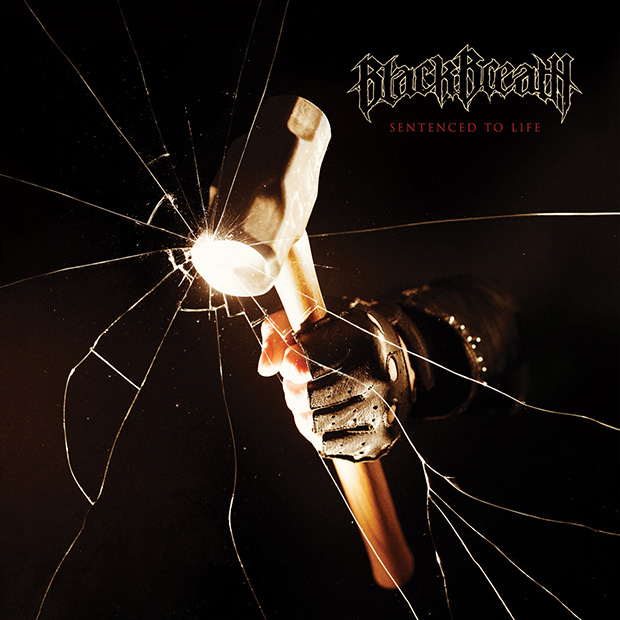
There are moments where I caught wind of wavering tempos in a couple of the songs. Was this part of a certain philosophy going into the album of capturing performances based on feel as opposed to perfection? Or did something slip through the cracks?
Wallace: In the studio, we would play through each song as we had while arranging and practicing for the recording session, and took notes of our natural tendency to speed up or slow down certain parts. Some riffs would work better slightly better fast or slower than the one before it so we tried to roll with that the best we could without it feeling too disjointed.
Byrum: Rarely anything slips through the cracks with Kurt at the helm, so all the tempo adjustments were a conscious decision for sure.
McAdams: Kurt’s console is haunted by the ghosts of those children he ate and sometimes they mix things around during sessions.
How much of the album was written by the time you got out to the east coast to start recording? Was there a lot of last minute scrambling done like there was on Sentenced to Life?
Wallace: There seemed to be a similar amount of scrambling this time around. Knowing that we could get things done under pressure helped out this time around, for sure. Once again, we basically constructed an entire track during our time at the studio, and laid pretty much all the vocal ideas down at night while we would listen back to the days’ takes on the shittiest stereo imaginable all huddled around the kitchen table littered with our various aids for concentration and stamina.
Byrum: The change in vocal delivery was a decision made literally the first day of tracking vocals. Many of the vocal takes that made it on to the record were Neil trying things for the first time in his life and I absolutely think it worked in our favour as it adds a cool unhinged kind of spontaneity to the whole thing. Kudos to Neil for surviving the hot seat, once again.
McAdams: Yeah, the vocals on the title track were the first takes I ever did like that. The record has such a different feel than our old stuff that I had to try something new vocally. I spent a lot of time singing Roy Orbison, Sam Cooke, Creedence Clearwater Revival and shit to stay warmed up. There was months of homicide research and filling up notebooks with ideas. I had a couple songs sorta worked out, but it wasn’t really until above mentioned late nights around the kitchen table with beer, whiskey and food from Steve’s Quality Market that the vocals got worked out and lyrics solidified. I had never sung any of the songs before tracking, but I was expecting that would happen so I knew what I was in for.
Check out the band live at Saint Vitus Bar, Dec. 14th, 2014 here.
What would you say were some of the more salient lessons learned during the period between the last album and the new one that were either consciously or subconsciously applied to Slaves Beyond Death?
Wallace: It took us a while to really focus on the approach to creating this record. With Sentenced, it was “let’s strip down everything to the most basic form, get in and get out.” Since we already did that, we couldn’t really do it again and feel like we challenged ourselves much. So, eventually we came to the conclusion we should attempt to make a record that’s bigger and more expansive than anything we had done. It’s quite helpful, for me at least, to have that kind of goal when writing, and I think for the other guys too. Otherwise, we just end up with more and more riffs but less of an idea what to do with them!
Byrum: I think one of the biggest lessons learned for me personally is don’t do what feels good in a song, do what feels right. They are often times not the same. The parts that I almost always regret the most are the ones that are really fun to play but may or may not be in poor taste. There are much fewer of those moments as the years go on and there’s really nothing I regret about the new record compositionally, which is a first.
McAdams: Recording Sentenced was a very hurried process and I was grasping at straws to come up with ideas and I knew I didn’t want to do that again. I brought much more material with me to work with this time but still ended up scrambling and writing half of it in Salem. So, did I learn anything? I think I did, but then ignored what I learned.
Was there a particular point that you felt what was coming out on tape (or hard drive, or whatever) was faithfully approximating what you’d heard in your heads during writing so much so that you felt you were on the right track?
Wallace: There is rarely a period of doubt with regards to the sounds we get out of recording at GodCity. We don’t really continue on if an instrument isn’t sounding the way we want. Pretty much as soon as we decided to return there to record this record, I knew we were on the right track. We tend to record songs the way we play them at home, so the experimentation in the studio tends to be kept to a minimum as far as gear and whatnot.
Byrum: Once we got the vocals squared away and Kurt figured out how to navigate Neil through it, I breathed an ENORMOUS sigh of relief. Up until that point, I was fairly stressed and unsure about the whole thing as it was extremely important to me that the vocals were as brutal and dark as the music. Neil exceeded my expectations.
McAdams: I had no idea what I was doing. So, I only had this vague ghostly concept in my head about what it might sound like. I was very nervous the first day I went in to track. I hadn’t been screaming at all for months. Warmed up with some Bill Withers, Thin Lizzy, The Righteous Brothers, hit some cheap bourbon and did it.
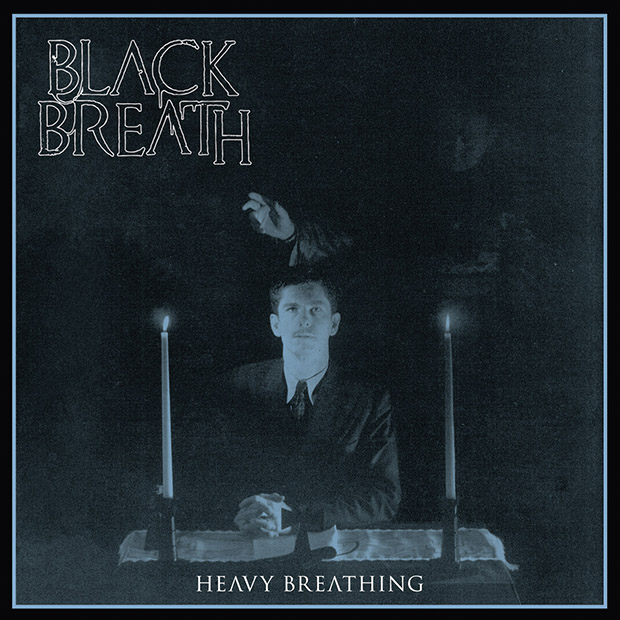
Any ridiculous stories from the studio you’d care to share? Like who (almost) spilled beer on the console? Did you “park your car in Harvard Yard?” Did your time in Massachusetts coincide with the endless snowfall that apparently happened last winter?
Wallace: Kurt ended up with some backstage passes to a Slipknot/Korn gig nearby while we were out there, so a few of us went. That was quite interesting.
Byrum: Honestly, this was probably the most tame and uneventful session yet. No real blows up or excitement. Outside of a few bad hangovers and a lot of junk food, the whole thing was pretty harmless.
McAdams: There was that bloodwitch orgy…
At what point in the process did you finalize the lyrics and song titles? Did a topical/lyrical theme emerge? What’s the story behind of the album’s title?
Wallace: The song titles generally get decided upon after all the music and vocals and everything are done being recorded, and we can reflect on the songs and choose words or phrases that seem the most fitting.
Byrum: Neil wrote all the lyrics and came up with all the song titles. He basically brings pages and pages of material and it all goes through a bit of a screening process with the rest of us. The moment he dropped “Slaves Beyond Death,” we all kind of just looked at each other and smiled and were like “Yep, that’s the one.” It leaves a lot of room for the imagination, whether it be as a slave to a corrupt and harsh society, or like a slave trapped in a basement being tortured before and after death. Basically, you’re a slave on Earth and slave in the afterlife. It’s a bit of a choose your own adventure scenario and “very metal.”
McAdams: The overall topical theme emerged while Jamie and I ate Vietnamese takeout food on these meth stairs overlooking the industrial part of Seattle and we probably started talking about Gary Ridgeway, the Green River Killer. Then, all these tweeked out motherfuckers started crawling out of the bushes and we bounced. I spent the next four months going down the serial murder rabbit hole with a notebook in one hand and a grass pipe in the other. The Pacific Northwest has a twisted history of serial murder. The D.C. sniper [John Allen Muhammad] applied for a cook job I eventually worked. So, it made a lot of sense. We grew up in the shadows cast by Ted Bundy, Ridgeway and Kenneth Bianchi (the Hillside Strangler). These people are real. Ridgeway is in a prison not far from where I sit now. He killed upwards of 80 women over a period of 20+ years. If you ever fly into Seattle where you land is where he hunted. If you ever drive east out of Seattle you are driving the same route Bundy used to cover up his necro-maniacal deeds. To me, these people are far more horrifying than any imaginary Christian devil.
Tell us about the cover art, its significance and how it relates to the title? Is there a story about going back and forth with the artist and multiple drafts, or was it a pretty smooth process?
Wallace: The process was pretty smooth, I enjoyed working with [artist] Paolo [Girardi]. A long email was sent outlining our general ideas, to which he responded and I think I sent one more with clarification on a few points. That was about it. Then, a month or two later, whenever his schedule opened up, he finished the painting and sent it to us. So, the first time we saw it was after it was complete.
Byrum: Paolo is an amazing artist and a total heavy metal maniac, so right from the get go I was pushing to work with him. He’s done so many amazing pieces in the last couple of years and I really believe in that style of metal artwork. There’s no one better in the world at the moment.
McAdams: I sent an email to Paolo offering some ideas I had about eternal torture and suffering beyond the grave and how one might construct a prison out of space-time to enslave another person’s soul.
With the experiences you’ve had in writing, recording and touring two previous albums, is there anything about this album promotional cycle that’s going to be different?
Wallace: Maybe we’ll play a show on top of the Space Needle this time…
Byrum: Heading to South America and playing for all the heavy metal lunatics down there would be a real treat and is on our “to do” list for sure.
McAdams: No one will be left unscathed by our seed.
-

 Music5 days ago
Music5 days agoTake That (w/ Olly Murs) Kick Off Four-Night Leeds Stint with Hit-Laden Spectacular [Photos]
-

 Alternative/Rock6 days ago
Alternative/Rock6 days agoThe V13 Fix #010 w/ High on Fire, NOFX, My Dying Bride and more
-

 Hardcore/Punk2 weeks ago
Hardcore/Punk2 weeks agoHastings Beat Punks Kid Kapichi Vent Their Frustrations at Leeds Beckett University [Photos]
-

 Alternative/Rock2 weeks ago
Alternative/Rock2 weeks agoA Rejuvenated Dream State are ‘Still Dreaming’ as They Bounce Into Manchester YES [Photos]
-

 Features5 days ago
Features5 days agoTour Diary: Gen & The Degenerates Party Their Way Across America
-

 Culture1 week ago
Culture1 week agoDan Carter & George Miller Chat Foodinati Live, Heavy Metal Charities and Pre-Gig Meals
-

 Music7 days ago
Music7 days agoReclusive Producer Stumbleine Premieres Beat-Driven New Single “Cinderhaze”
-

 Alternative/Rock1 week ago
Alternative/Rock1 week agoThree Lefts and a Right Premiere Their Guitar-Driven Single “Lovulator”



